2007 GMC SIERRA CLASSIC ECO mode
[x] Cancel search: ECO modePage 65 of 674

{CAUTION:
Children can be seriously injured or
strangled if a shoulder belt is wrapped
around their neck and the safety belt
continues to tighten. Secure any unused
safety belts behind the child restraint so
children cannot reach them. Pull the
shoulder belt all the way out of the
retractor to set the lock, if your vehicle
has one, after the child restraint has been
installed. Be sure to follow the
instructions of the child restraint
manufacturer.
Notice:Contact between the child restraint or
the LATCH attachment parts and the vehicle’s
safety belt assembly may cause damage to
these parts. Make sure when securing unused
safety belts behind the child restraint that
there is no contact between the child restraint
or the LATCH attachment parts and the
vehicle’s safety belt assembly.Folding an empty rear seat with the safety
belts secured may cause damage to the safety
belt or the seat. When removing the child
restraint, always remember to return the safety
belts to their normal, stowed position before
folding the rear seat.
Regular Cab Models
1. If the child restraint manufacturer recommends
that the top tether be attached, attach and
tighten the top tether to the top tether anchor,
if your vehicle has one. Refer to the child
restraint instructions and the following steps:
1.1. Pull the passenger seatback forward
by pulling the recliner handle upward to
access the top tether anchor. See
Reclining Seatbacks on page 15for
additional information.
1.2. Find the top tether anchor.
1.3. Remove the trim cover to expose the
anchor.
1.4. Route, attach, and tighten the top tether
according to your child restraint
instructions and the following
instructions:
65
Page 67 of 674
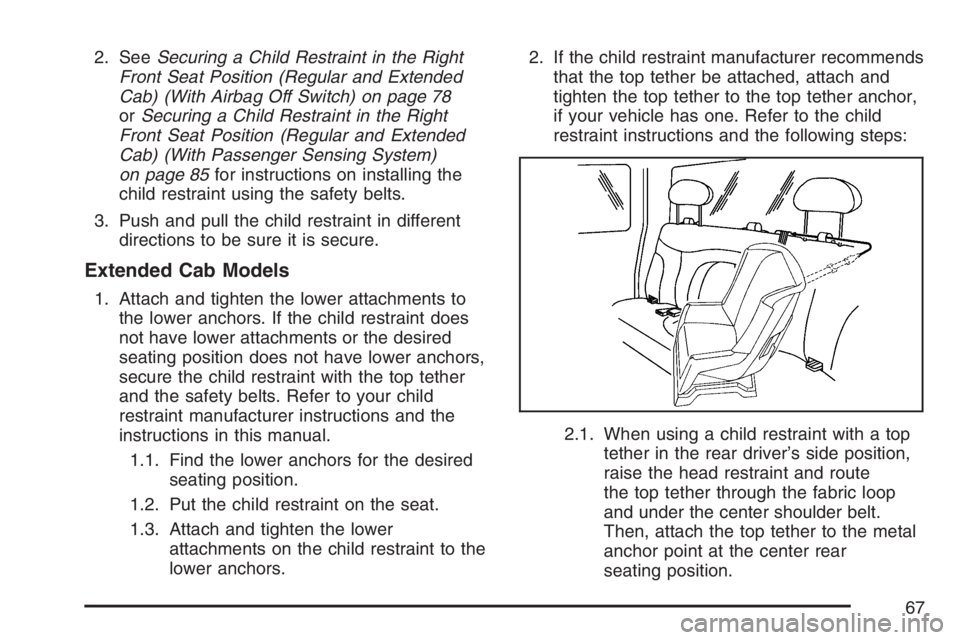
2. SeeSecuring a Child Restraint in the Right
Front Seat Position (Regular and Extended
Cab) (With Airbag Off Switch) on page 78
orSecuring a Child Restraint in the Right
Front Seat Position (Regular and Extended
Cab) (With Passenger Sensing System)
on page 85for instructions on installing the
child restraint using the safety belts.
3. Push and pull the child restraint in different
directions to be sure it is secure.
Extended Cab Models
1. Attach and tighten the lower attachments to
the lower anchors. If the child restraint does
not have lower attachments or the desired
seating position does not have lower anchors,
secure the child restraint with the top tether
and the safety belts. Refer to your child
restraint manufacturer instructions and the
instructions in this manual.
1.1. Find the lower anchors for the desired
seating position.
1.2. Put the child restraint on the seat.
1.3. Attach and tighten the lower
attachments on the child restraint to the
lower anchors.2. If the child restraint manufacturer recommends
that the top tether be attached, attach and
tighten the top tether to the top tether anchor,
if your vehicle has one. Refer to the child
restraint instructions and the following steps:
2.1. When using a child restraint with a top
tether in the rear driver’s side position,
raise the head restraint and route
the top tether through the fabric loop
and under the center shoulder belt.
Then, attach the top tether to the metal
anchor point at the center rear
seating position.
67
Page 69 of 674
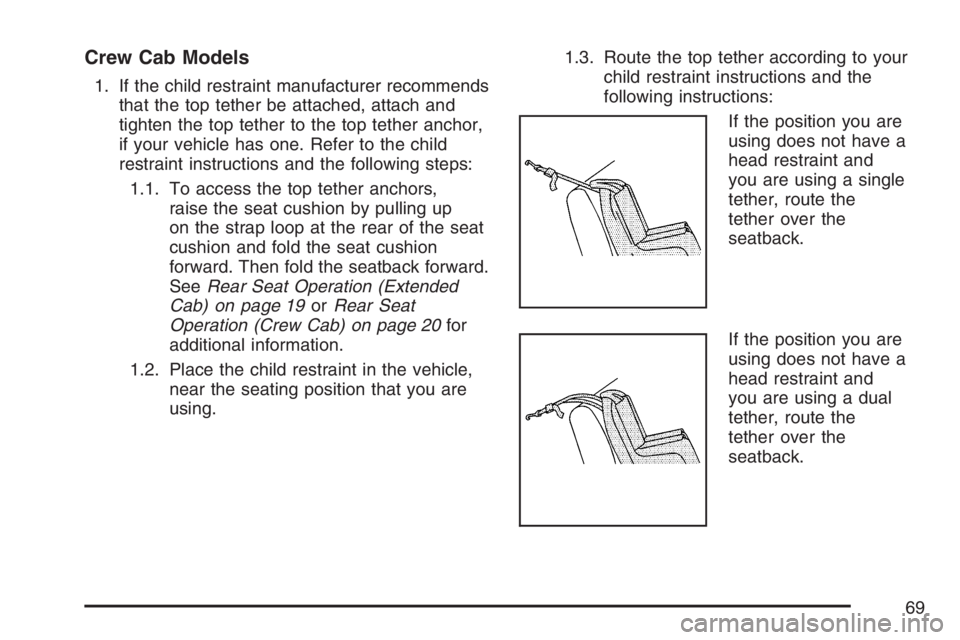
Crew Cab Models
1. If the child restraint manufacturer recommends
that the top tether be attached, attach and
tighten the top tether to the top tether anchor,
if your vehicle has one. Refer to the child
restraint instructions and the following steps:
1.1. To access the top tether anchors,
raise the seat cushion by pulling up
on the strap loop at the rear of the seat
cushion and fold the seat cushion
forward. Then fold the seatback forward.
SeeRear Seat Operation (Extended
Cab) on page 19orRear Seat
Operation (Crew Cab) on page 20for
additional information.
1.2. Place the child restraint in the vehicle,
near the seating position that you are
using.1.3. Route the top tether according to your
child restraint instructions and the
following instructions:
If the position you are
using does not have a
head restraint and
you are using a single
tether, route the
tether over the
seatback.
If the position you are
using does not have a
head restraint and
you are using a dual
tether, route the
tether over the
seatback.
69
Page 123 of 674
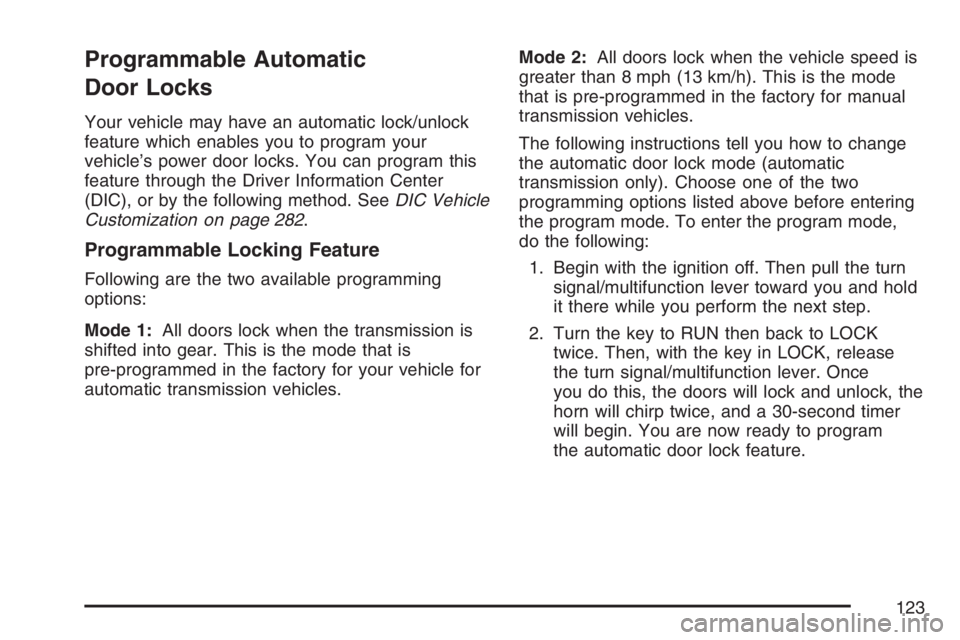
Programmable Automatic
Door Locks
Your vehicle may have an automatic lock/unlock
feature which enables you to program your
vehicle’s power door locks. You can program this
feature through the Driver Information Center
(DIC), or by the following method. SeeDIC Vehicle
Customization on page 282.
Programmable Locking Feature
Following are the two available programming
options:
Mode 1:All doors lock when the transmission is
shifted into gear. This is the mode that is
pre-programmed in the factory for your vehicle for
automatic transmission vehicles.Mode 2:All doors lock when the vehicle speed is
greater than 8 mph (13 km/h). This is the mode
that is pre-programmed in the factory for manual
transmission vehicles.
The following instructions tell you how to change
the automatic door lock mode (automatic
transmission only). Choose one of the two
programming options listed above before entering
the program mode. To enter the program mode,
do the following:
1. Begin with the ignition off. Then pull the turn
signal/multifunction lever toward you and hold
it there while you perform the next step.
2. Turn the key to RUN then back to LOCK
twice. Then, with the key in LOCK, release
the turn signal/multifunction lever. Once
you do this, the doors will lock and unlock, the
horn will chirp twice, and a 30-second timer
will begin. You are now ready to program
the automatic door lock feature.
123
Page 124 of 674
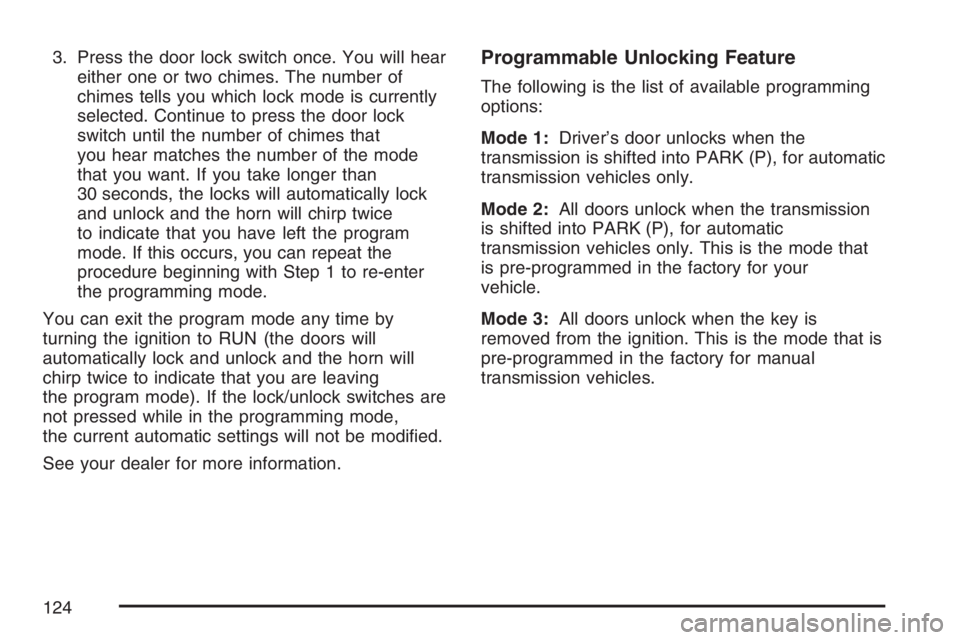
3. Press the door lock switch once. You will hear
either one or two chimes. The number of
chimes tells you which lock mode is currently
selected. Continue to press the door lock
switch until the number of chimes that
you hear matches the number of the mode
that you want. If you take longer than
30 seconds, the locks will automatically lock
and unlock and the horn will chirp twice
to indicate that you have left the program
mode. If this occurs, you can repeat the
procedure beginning with Step 1 to re-enter
the programming mode.
You can exit the program mode any time by
turning the ignition to RUN (the doors will
automatically lock and unlock and the horn will
chirp twice to indicate that you are leaving
the program mode). If the lock/unlock switches are
not pressed while in the programming mode,
the current automatic settings will not be modi�ed.
See your dealer for more information.Programmable Unlocking Feature
The following is the list of available programming
options:
Mode 1:Driver’s door unlocks when the
transmission is shifted into PARK (P), for automatic
transmission vehicles only.
Mode 2:All doors unlock when the transmission
is shifted into PARK (P), for automatic
transmission vehicles only. This is the mode that
is pre-programmed in the factory for your
vehicle.
Mode 3:All doors unlock when the key is
removed from the ignition. This is the mode that is
pre-programmed in the factory for manual
transmission vehicles.
124
Page 125 of 674
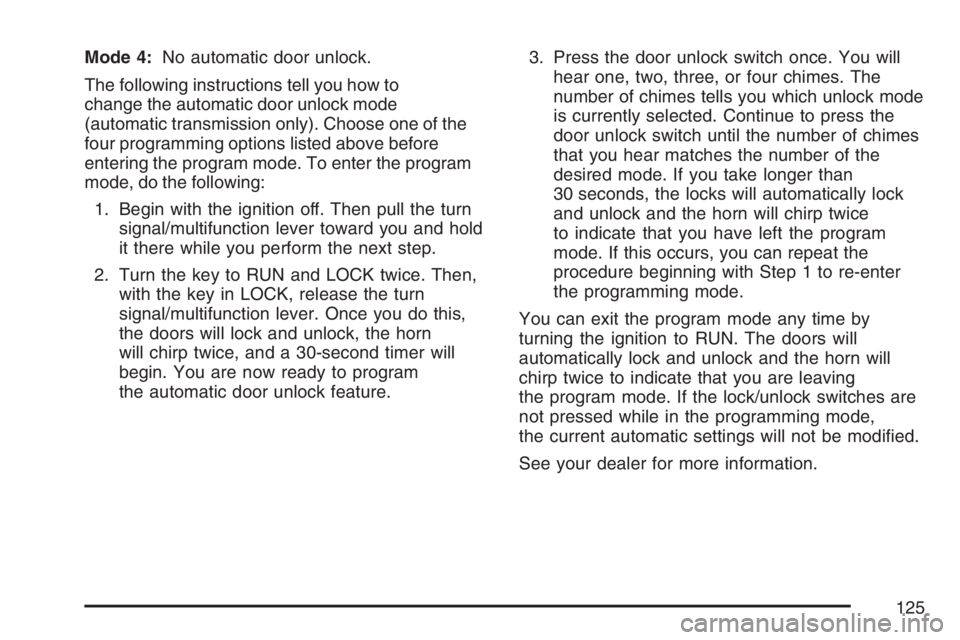
Mode 4:No automatic door unlock.
The following instructions tell you how to
change the automatic door unlock mode
(automatic transmission only). Choose one of the
four programming options listed above before
entering the program mode. To enter the program
mode, do the following:
1. Begin with the ignition off. Then pull the turn
signal/multifunction lever toward you and hold
it there while you perform the next step.
2. Turn the key to RUN and LOCK twice. Then,
with the key in LOCK, release the turn
signal/multifunction lever. Once you do this,
the doors will lock and unlock, the horn
will chirp twice, and a 30-second timer will
begin. You are now ready to program
the automatic door unlock feature.3. Press the door unlock switch once. You will
hear one, two, three, or four chimes. The
number of chimes tells you which unlock mode
is currently selected. Continue to press the
door unlock switch until the number of chimes
that you hear matches the number of the
desired mode. If you take longer than
30 seconds, the locks will automatically lock
and unlock and the horn will chirp twice
to indicate that you have left the program
mode. If this occurs, you can repeat the
procedure beginning with Step 1 to re-enter
the programming mode.
You can exit the program mode any time by
turning the ignition to RUN. The doors will
automatically lock and unlock and the horn will
chirp twice to indicate that you are leaving
the program mode. If the lock/unlock switches are
not pressed while in the programming mode,
the current automatic settings will not be modi�ed.
See your dealer for more information.
125
Page 144 of 674
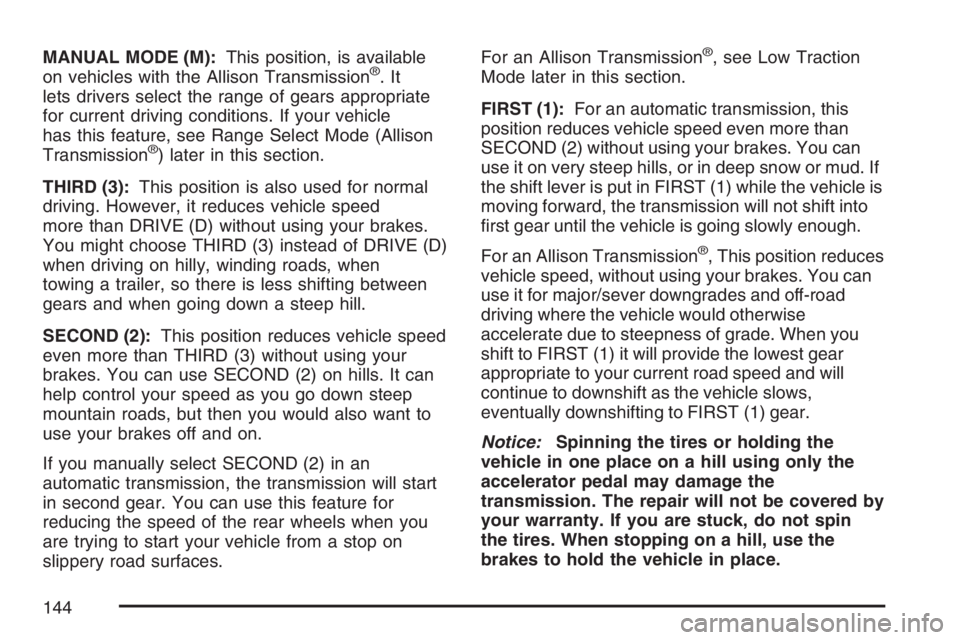
MANUAL MODE (M):This position, is available
on vehicles with the Allison Transmission®.It
lets drivers select the range of gears appropriate
for current driving conditions. If your vehicle
has this feature, see Range Select Mode (Allison
Transmission
®) later in this section.
THIRD (3):This position is also used for normal
driving. However, it reduces vehicle speed
more than DRIVE (D) without using your brakes.
You might choose THIRD (3) instead of DRIVE (D)
when driving on hilly, winding roads, when
towing a trailer, so there is less shifting between
gears and when going down a steep hill.
SECOND (2):This position reduces vehicle speed
even more than THIRD (3) without using your
brakes. You can use SECOND (2) on hills. It can
help control your speed as you go down steep
mountain roads, but then you would also want to
use your brakes off and on.
If you manually select SECOND (2) in an
automatic transmission, the transmission will start
in second gear. You can use this feature for
reducing the speed of the rear wheels when you
are trying to start your vehicle from a stop on
slippery road surfaces.For an Allison Transmission
®, see Low Traction
Mode later in this section.
FIRST (1):For an automatic transmission, this
position reduces vehicle speed even more than
SECOND (2) without using your brakes. You can
use it on very steep hills, or in deep snow or mud. If
the shift lever is put in FIRST (1) while the vehicle is
moving forward, the transmission will not shift into
�rst gear until the vehicle is going slowly enough.
For an Allison Transmission
®, This position reduces
vehicle speed, without using your brakes. You can
use it for major/sever downgrades and off-road
driving where the vehicle would otherwise
accelerate due to steepness of grade. When you
shift to FIRST (1) it will provide the lowest gear
appropriate to your current road speed and will
continue to downshift as the vehicle slows,
eventually downshifting to FIRST (1) gear.
Notice:Spinning the tires or holding the
vehicle in one place on a hill using only the
accelerator pedal may damage the
transmission. The repair will not be covered by
your warranty. If you are stuck, do not spin
the tires. When stopping on a hill, use the
brakes to hold the vehicle in place.
144
Page 146 of 674

Low Traction Mode
(Allison Transmission®)
If your vehicle has the DURAMAX®diesel engine
and the Allison Transmission®,ithasaLow
Traction Mode that assists in vehicle acceleration
when road conditions are slippery, such as
with ice or snow. While at a stop, selecting the
second gear range using the Range Selection
system, will allow the Allison Transmission
®to limit
torque to the wheels after it detects wheel slip,
preventing the tires from spinning.
Notice:Spinning the tires or holding the
vehicle in one place on a hill using only the
accelerator pedal may damage the
transmission. The repair will not be covered by
your warranty. If you are stuck, do not spin
the tires. When stopping on a hill, use the
brakes to hold the vehicle in place.
Cold Weather Operation
(Allison Transmission®)
On cold days, approximately 32°F (0°C) or colder,
your automatic transmission is designed to shift
differently. The transmission uses a warm-up mode
shift schedule until the engine reaches normal
operating temperature. While the transmission is
in warm-up mode it is normal for transmission
upshifts to be delayed or held longer. This feature
improves heater performance by giving quicker
vehicle warm-ups.
When temperatures are below−13°F (−25°C), the
transmission will prevent certain operations to
protect against damage. When active the DIC will
display the message “Trans in Warm-up”.
SeeDIC Warnings and Messages on page 270for
more information.
146